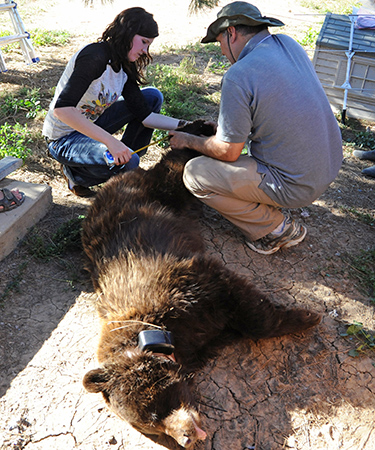
Highlands University biology graduate student Casey Taylor, left, and her adviser, Jésus Rivas, measure the hind foot of a black bear.
Las Vegas, NM — A Highlands University biology graduate student is studying black bears that move between wild and urban areas in Northern New Mexico.
While urban wildlife like coyotes and raccoons are a growing area of research, Casey Taylor’s thesis research is one of the first to study bears.
Taylor’s study is assessing the movement and density of the urban black bear — Ursus americanus — population in Las Vegas and Raton. One component of her fieldwork includes radio tracking two black bear sows — including the one that visited Las Vegas in September with her two cubs in search of food.
Taylor’s research also includes a genetic lab component. She’s using the bear scat and hair samples she collects around dumpsters to create genetic profiles of multiple bears using microsatellites — repeats in the DNA sequence that are commonly called the DNA fingerprint.
“Conflicts between humans and black bears are growing due to habitat degradation, human expansion into black bear habitat, and easy urban food sources for bears, like dumpsters and dog food,” Taylor said. “I’m doing a collaborative study with the New Mexico Game and Fish Department, where they collar the bears for radio telemetry when they come into town. Then I track the bears and we share data.”
Taylor, a 24-year-old Minnesota native, said her study explores how bears stop using the rural ecosystem exclusively and become urban animals, adding that it’s important to know more about urban bears in order to protect their welfare.
Andrew Gray is the captain of the northeastern region for New Mexico Game and Fish.
“We catch and release a lot of urban bears around Raton, while the Las Vegas bear problem is sporadic and weather dependent, with more bears coming into town in these drier years,” Gray said. “Casey’s research is valuable to Game and Fish because it gives us new information on behavioral patterns of the bears, including how they respond to humane adverse conditioning –like paintballing – that we use to discourage human-bear interaction.
“Casey is a very dedicated hard worker with an aptitude for fieldwork — whether she’s collecting bear scat or tracking them with telemetry equipment. I think she has a bright future in the wildlife field,” Gray said.
Taylor said it was very exciting to have the chance to touch and hold the bears after they were tranquilized.
“We took the standard protocol measurements — like lengths for the body, ear, tail and left hind foot. We’re tracking the Las Vegas area bear that was released on Game and Fish property near the Las Vegas National Wildlife Refuge. She hasn’t come back to town, probably because it’s close to winter and she’s found a den site to hibernate with her cubs. The radio collars have a two-year battery, so we can track her again in the spring when she comes out of hibernation,” Taylor said.
She said that the Raton area bear has crossed the state line into Colorado.
Biology professor Jésus Rivas is Taylor’s adviser for her thesis.
“What’s new about about Casey’s research is that we’re trying to understand the biology of bears in a more comprehensive way, including urban environments,” Rivas said. “We throw away so much food that it can support a population of bears. The biggest problem is not managing the bears, it’s managing the people.”
Rivas said that Taylor’s research is the kind of applied, real-world ecological research that Highlands provides for its students.
“Casey is a very smart, capable and independent thinker who shows great potential as a researcher,” Rivas said.
Taylor is a graduate teaching assistant for several biology courses. The university’s Sigma Xi chapter provided funding for her microsatellite genetic research on black bears.
“The biology research opportunities at Highlands are great. I had the opportunity to design a thesis project that I’m passionate about, with the help of Dr. Jésus Rivas and Dr. Sarah Corey-Rivas. I’ve been working closely with both of them,” Taylor said.
Looking ahead, Taylor plans to continue her education after she completes her master’s at Highlands in May 2014.
“My ultimate goal is to pursue my Ph.D. and continue my research with large carnivores and molecular ecology. I’ve taken a liking to bears and may study them further. They’re such an intriguing species,” Taylor said.
